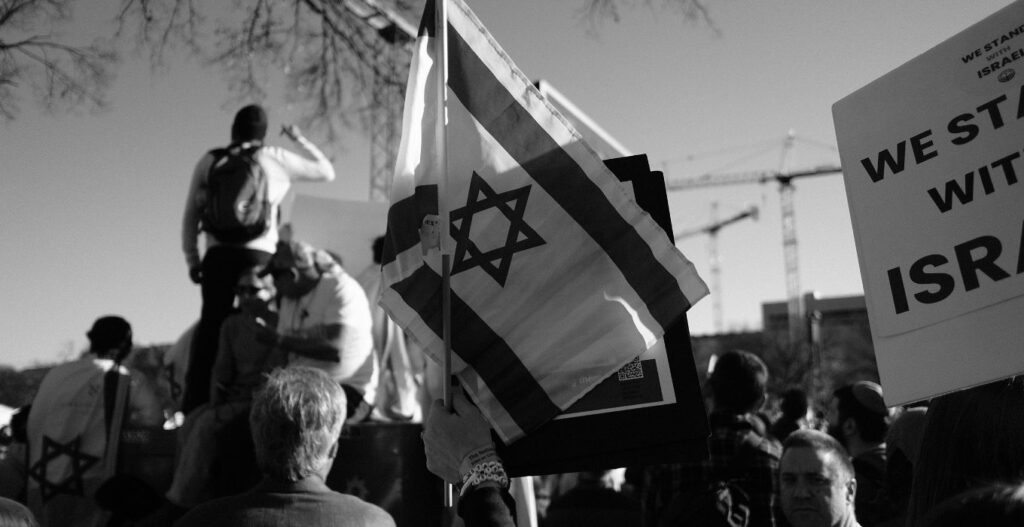WASHINGTON – In the late 1970s, Cindy Amberger, like many other American Jewish teenagers, spent time on an Israeli kibbutz with a host family to connect with the country and the land.
Just four kilometers from Gaza, Kibbutz Kisufim was a formative place for Amberger, who is now 66 years old and living in Minnetonka, and she’s stayed in touch with her adoptive family ever since.
But on Oct. 7, Kibbutz Kisufim was one of the Israeli communities attacked by Hamas, the Gazan terrorist organization, which brutally massacred 1,200 Israeli civilians and took nearly 250 hostages.
“I immediately searched and searched for any information I could find on this family and other people [on the kibbutz],” Amberger said.
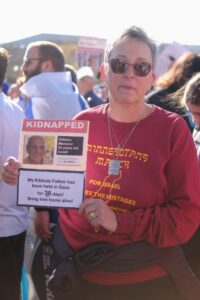
Cindy Amberger holds a kidnapped poster of her “kibbutz father” Shlomo Mansour, who was taken from Kibbutz Kisufim (Photo by Lev Gringauz/TC Jewfolk).
She learned from the Kibbutz Kisufim Facebook page that her host family survived the attack – but her host father, 85-year-old Shlomo Mansour, was taken hostage by Hamas.
“It’s challenging being in communication with [Mansour’s wife] and her daughters now,” Amberger said. “But I hope that he can be released and that he’s as well as can be.”
That connection drove her to come to Washington, D.C., on Tuesday to attend the “March for Israel,” a rally at the National Mall that – despite a permit for 60,000 people – swelled to an estimated 290,000 participants who came to show support for Israelis amid the country’s war with Hamas, call for the release of hostages held by Hamas in Gaza, and protest skyrocketing global antisemitism in the wake of the war.
The largest American Jewish rally in history brought together American Jews and allies in grief, but also, in pride for Israel and the Jewish people. Amid chants of “bring them home” and “am Israel chai (the people of Israel live),” the rally had a cathartic – at times even joyful and celebratory – feel.
“This is so empowering and so heartwarming,” said Amberger at the rally, holding a sign calling for the release of Mansour amid the busy crowd and blaring speakers. “It’s so easy to just scroll through Instagram and get bad news after bad news after bad news. And there’s so much life and vitality and love here that this is really an important event.”
Amberger was one of over 200 rally participants from Minnesota, and part of the roughly 180-strong trip to D.C. organized by the Minneapolis Jewish Federation. Participants included Jews of all ages, clergy from synagogues around the Twin Cities, and a contingent of 12 students from Minnesota Hillel.
Despite an attempt to stay in one group at the rally, the Federation trip participants spread as if by osmosis through the crowd, only identifiable as Minnesotans by their shirts – maroon with gold lettering. On the front, they said, “Minnesotans March for Israel, to free the hostages, against antisemitism.” On the back, the Minneapolis Jewish Federation logo and “#bringthemhome.”
Being at the rally held a mixture of “anxiety, anxiousness, happiness, and relief,” said Gabriel Flaum, 30, from Bloomington. “I needed to be here, I had to be here. There was no discussion…On a scale of one to 10, this is an 18.”
Every community, it seems, made clear where they came from: Jews from Texas had their state flag on sweaters, and various posters had “[name of community] stands with Israel” written on them. Jewish humor was also on display, with widespread joking about the event being called a march – but not actually including any marching.
Meanwhile, 12,000 students came from Jewish day schools, throngs of college students wore matching sweatshirts, and Chabad rabbis looking to get Jewish men to put on tefillin had a field day speeding up the coming of the messiah with countless asks and wraps.
For some Minnesotans, there was a unique pride and need to represent themselves at the rally.
“It is so important that we stand up and make a very loud noise, and not just hope, ‘Nope, our neighbors don’t really notice us,’” said St. Paul-ite Katherine Tane, 69, the former executive director of the Jewish Historical Society of the Upper Midwest.
Tane spoke against what she sees as a kind of Minnesota Jewish meekness in some parts of the community, with some not wanting to take a public stance on the Israel-Hamas war or being afraid to put out signs in support of Israel.
It feels to her like a far cry from meeting the needs of the moment – something Minnesotan Jewry did full-throttle in the past, like when resettling the most Soviet Jews per capita in the United States, Tane said.
“I do think this is a particular inflection point in our history because of all the worldwide attacks on Israel,” Tane said. “So it’s another time for Minnesotan Jews to shine and not be afraid to come forward.”
Everyone recognized a sense of making history by being at the rally.
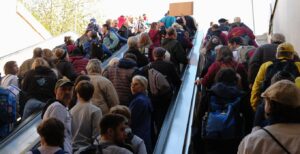
Thousands ride the escalators to the street at the Washington, D.C. Metro station near the Mall. (Photo by Lev Gringauz/TC Jewfolk).
“Whether it’s a shirt or swag or my sign in 50 years that my grandchildren will have in a box — there aren’t very many opportunities to be a real part of history and I think this is one of them,” Amberger said.
Students from Hillel had a similar conversation with each other.
“Everyone from Hillel feels like we’re really gonna remember this day,” said Izzy Lundquist, a senior at the University of Minnesota and a member of the Minnesota Hillel student board. “It feels like a very influential moment in the history of the Jewish people, and it’s important that we stand with the people of Israel. So we’re really glad that we can come here and do that with so many other people today.”
While much of the rally was about community and finding support, there was also an element of advocacy, and showing that there is much more to the conversation around the Israel-Hamas war than coverage of pro-Palestinian rallies and and the views of the anti-Zionist corner of the Jewish community. Polls show that across the Jewish world and in the U.S., most Americans and Jews support Israel and see the war as Hamas’ fault (though what that means for policy can be confusing).
“There’s no other better way to put an exclamation point on what we all know is true than 290,000 people on a Tuesday – not a Sunday, on a Tuesday – coming to the Capitol,” said Ethan Roberts, deputy executive director of the Jewish Community Relations Council of Minnesota and the Dakotas.
“We were part of what needed to be done, which was to just refocus, at least for a few hours, on 240 hostages, on the brutality of October 7, and the necessity for Israel to win this war,” he said.
Rally participants also had a keen sense that Israelis were watching.
“This is vitally important – I can’t stress this enough – that the people in Israel see that this is what’s happening here,” Amberger said. “Their spirit is eroding. Too many funerals, too much bad news. When they see the Jews in America gathering like this, it makes a difference.”
The March
The “March for Israel” was organized by the Jewish Federations of North America and the Conference of Presidents of Major American Jewish Organizations to “make sure the world doesn’t forget” about antisemitism, JFNA’s president and CEO Eric Fingerhut told The Jerusalem Post before the event.
For Fingerhut, it was also about taking a public stand in support of Israel despite widespread anti-Israel sentiment, which has terrified Jews on college campuses and their families, and led to increased security concerns in Jewish communities.
“We think it’s really important to stand up and say that we will not be intimidated,” Fingerhut said. “America is not an antisemitic nation, and we won’t let it become one.”
Speakers at the rally spanned cultural figures like Broadway star Tovah Feldshuh; renowned activists like Soviet-Jewish human rights activist Natan Sharansky; and a long list of U.S. officials like the U.S. special envoy to combat antisemitism, Amb. Deborah Lipstadt, Democratic and Republican leaders of the House and Senate, and co-chairs of a bipartisan task force combating antisemitism; and families of the hostages held by Hamas.
“The pain I have experienced since they were taken has been so sharp it follows my every breath,” said Alana Zeitchik, a cousin of six Israelis taken hostage by Hamas.
Zeitchik, wearing six pins on her jacket with the faces of her cousins, told how the family, mostly children, were sheltering from the Hamas attack in a bomb shelter on Kibbutz Nir Oz. Once it was too filled with smoke to be safe – Hamas purposefully set fire to homes and shelter areas to drive people out of safe rooms – one of the cousins sent a voice note to the family group chat, saying simply, “We’re not going to make it out of this. We love you.”
“I promised I would scream to the ends of the earth for them,” Zeitchik said. “This unwavering love of family is the heart of what it means to be Jewish.”
She spoke against people who don’t want to sympathize with the hostages and their families, like activists who have been tearing down posters raising awareness of the hostages across the U.S.
“The simple human truth is that you don’t have to choose: You can abhor the suffering of Palestinian families and the suffering of Israeli families like mine,” Zeitchik said. “You can call for peace and the immediate return of the innocent men, women and children who were violently taken from us.”
Rachel Goldberg, the mother of hostage Hersh Goldberg-Polin, raged against the world’s seeming inability to get the hostages back home from the Gaza tunnels where they are held.
“The real souls suffering are those of the hostages, and they want to ask everyone in the world…The indignant, the haters, the leaders, the lovers, every single one of us: Why? Why is the world accepting that 240 human beings from almost 30 countries have been stolen and buried alive?” she said.
Goldberg confronted the rally audience as complicit in that failure.
“There was a Christian German who hid Jews during the Holocaust, and he was asked why he did such a heroic and dangerous act. His answer was simple – ‘At least I will know when I die and stand before God, he will not ask me what he asked Cain in the Bible: Where were you when your brother’s blood cried out from the ground?’” Goldberg said.
“What the world needs to start thinking about today is: What will your excuse be?”
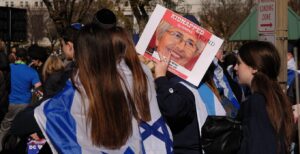
“Kidnapped” signs for Vivian Silver, an Israeli-Canadian peace activist, changed to “murdered” after her body was identified recently. (Photo by Lev Gringauz/TC Jewfolk)
Small details spoke large stories at the rally: A photo of 74-year-old Vivian Silver, an Israeli-Canadian peace activist presumed for weeks to be a hostage, was everywhere on posters. But only days ago, her body was identified out of the rubble of her Kibbutz Be’eri home – she had been killed on Oct. 7.
One student at the rally crossed out the word “kidnapped” on her poster of Silver and wrote, in marker, the word “murdered.”
Another face on the posters, 19-year-old Israel Defense Forces soldier Noa Marciano, was taken hostage by Hamas. But on Monday, Hamas published a gruesome video that showed a forced interview with Marciano intercut with video of her dead body. Israel confirmed her death.
Relief and rabbinic moments
Amid the mix of emotions at the rally, many Jews felt a significant sense of relief. Rather than feel the need to be constantly on guard around peers, a rally full of differing, but largely like-minded, people meant being able to relax.
“It’s been really hard just to be fully authentic in my Judaism ever since October 7,” said Izzy Lundquist, the senior at the University of Minnesota who came to the rally with the Minnesota Hillel group. The relief of the rally felt even more significant given the tense atmosphere on college campuses.
“I’ve found myself being careful about what I say or what I post on social media because of how people might interpret it,” Lundquist said. “So being here in an environment where I know that I won’t be misinterpreted or taken in bad faith is really, really exciting…It’s nice not having to qualify your hopes for Israel. Here, people know that you want the best for humanity.”
Some Jewish professionals also found a moment of peace at the rally, much-needed after being in the position of communal caregivers nonstop since Oct. 7. It was a break from work and responsibility, and a chance to recharge without being in the spotlight.
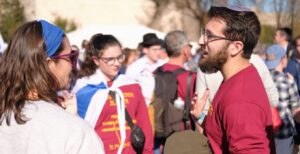
Beth El Synagogue Associate Rabbi Matt Goldberg (R) talks to a march participant. (Photo by Lev Gringauz/TC Jewfolk).
“I had a teacher who would say, sometimes you get to just be a Jew in the pews, as opposed to being the leader being on the bima,” said Rabbi Matt Goldberg, assistant rabbi at Beth El Synagogue in St. Louis Park. “Sometimes it’s nice to just be one among the thousands. So I’m getting a lot out of that today.”
The size of the rally and the Minnesota delegation eased, if only for a moment, a deep sense of isolation many Jews feel in their pain after the events of Oct. 7 and the world’s response.
“I feel comforted, I feel reinvigorated” being at the rally, Goldberg said. “It’s hard to keep scrolling through social media when so much of it is garbage. One of the speakers said we feel isolated – I think that’s been the biggest thing for me, I feel a little bit abandoned by friends and by social media influencers and by certain politicians and by certain loud voices.”
The crowd and speakers at the rally also gave an essential reminder that individual Jewish communities are not alone in their struggles, and that Jews as a whole have wide-ranging support from allies and the U.S. government.

Temple of Aaron Rabbi Marcus Rubenstein talks to the Minnesota participants of the March For Israel before leaving Minneapolis on Nov. 14, 2023. (Photo by Lev Gringauz/TC Jewfolk).
“An important point that was made a couple of times is that not only Israel, but also America should be safe for Jews,” Goldberg said. “The fact that these politicians and these speakers have reiterated over and over that Jewish people should find safety and peace…in the Jewish state, and also in every zip code in America – I’m grateful for that reminder.”
Throughout the day, Minnesota clergy helped frame the moment for the Minneapolis Jewish Federation trip. At the gate in the early morning on Tuesday, cantors led the group in a round of “Ozi v’Zimrat Yah” (The Lord is my strength), with other songs and prayers sung on the flights to and from D.C.
Clergy helped set the tone for the trip with a sense of humor and intention. Before saying a prayer for safe travels on the flight to D.C., Bet Shalom’s Rabbi David Locketz prompted laughter by noting, “This is fulfilling a life dream of mine, getting to speak from the front of the plane.”
Beth El’s Rabbi Alexander Davis called the trip an aliyah, a physical and spiritual ascent.
“This is an aliyah to raise awareness of antisemitism, to raise our consciousness and hold in our hearts those who are hostage, and this is an aliyah to lift all of our spirits,” he said.
On the flight back to Minnesota, Temple Israel’s Rabbi Marcia Zimmerman spoke about transforming the paralyzing fear many Jews felt after Hamas’ attack into positive action, navigating a way forward in what often feels like a frail and dark world.
“Today, we did something with that fear – we actually found agency,” Zimmerman said. “The idea that we got up as North American Jews to show our numbers and our connection and our comradery and our one voice is what is allowing us to take our fear and move forward with it.”
There were other, smaller moments of connection. On the return flight, participants were recorded singing the happy birthday song in Hebrew – with the audio to be sent to an IDF soldier serving in Gaza who will be celebrating his birthday soon.
The soldier is the nephew of one of the participants on the Federation trip. As people sang, his aunt stood at the front of the plane, looking tired, but defiant.

